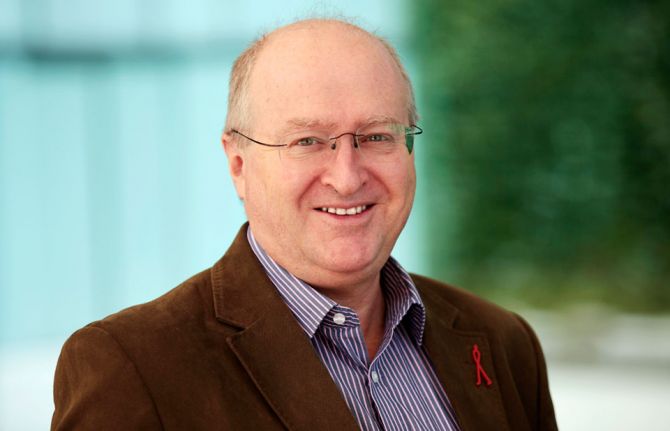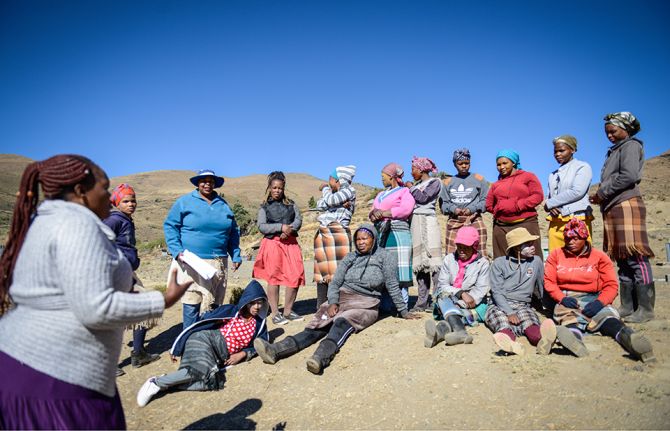

Feature Story
How London’s first dedicated HIV ward changed the AIDS response
03 October 2019
03 October 2019 03 October 2019Opened in 1987 by Princess Diana, the Broderip Ward at the Middlesex Hospital in London was the United Kingdom’s first ward dedicated to caring for HIV patients. UNAIDS Senior Adviser on Science, Peter Godfrey-Faussett, worked on the Broderip Ward as a newly qualified doctor and remembers it as an intense and highly emotional period.
What are your first memories of HIV?
I was finishing my medical training in London when the first reports of what would subsequently be called HIV and AIDS came out. We had no idea then of the unprecedented nature of what was happening. As a medical student approaching my final exams, my concern was to know the facts, but it was clear to me even then that many of these “facts” were not yet understood. After qualifying, I soon found myself working at the Hospital for Tropical Diseases in London and on the Broderip Ward at the Middlesex Hospital.
How did London’s medical professionals react to this new health challenge?
The organization of services for HIV varied in different parts of London. The staff at the sexual health clinics, or departments of genitourinary medicine, as they were called then, were establishing outpatient services with counselling, support and care for people living with HIV. But these teams were generally not well equipped to provide care for people who had to be admitted to hospital. In each hospital, a different specialist team took on the care of the ever-expanding population of people living with, and dying from, HIV. Many of those needing care had pneumonia, often caused by pneumocystis. Others had persistent severe diarrhoea, neurological problems or skin diseases, including Kaposi's sarcoma.
We had an amazing team led by Steve Semple and worked in close collaboration with the staff at James Pringle House, one of the dedicated sexual health clinics in London. Steve Semple was a respiratory physician with an expertise in the normal regulation of breathing. In other parts of London, the leaders were gastroenterologists, immunologists or infectious disease physicians.
We were all learning quickly how best to care for a wider range of infections, cancers and other conditions, all while coming to understand the social networks and behaviours of our mostly gay patients.
It must have been a difficult time
It was, of course, a hugely sad time. We could treat many opportunistic infections and provide counselling and support, but HIV was almost invariably lethal in those days and we saw so many young men, who were often at the forefront of the lively and creative communities that made London such a great city, fade away gradually or deteriorate more suddenly and die.
As a medical student and young doctor, most of the people that I had treated were reaching the end of full productive lives, but here on the Broderip Ward were people of my own age, reading the same books, going to the same operas and plays. It was often hard to remain clinically detached. I can remember so many of them so clearly. And so many of their loved ones and families.
How did the opening of the Broderip Ward change the way people were cared for?
The nurse in charge of the ward, Jacqui Elliott, was a wonderful woman. Along with Steve Semple, she encouraged us all to break the mould and provide care in a very different way. Back then, hospitals were quite old fashioned and regimented. The matron and the consultant were at the point of a huge pyramid, and often the patients were near the bottom!
Right from the start we engaged with the patients and their partners, and, where necessary, turned a blind eye to regulations. The ward was the only one in the hospital to have additional fridges full of delicious meals that people brought in for their partners, often shared with other patients and the health team!
In those days, there were payphone kiosks at the end of long cold corridors in the hospital and hospital gowns were hideous affairs that tied up loosely at the back. We were the first ward to install a phone on the nurses’ desk so that patients could make calls more easily. We encouraged people to wear their own clothes and dressing gowns and to come and go from the ward as they wished. Everyone on Broderip worked around the clock. Our parties were the ones that everyone in the hospital wanted to come to.
We were learning, and no doubt we made mistakes, but we were certainly among the first medical professionals to listen to our patients and to try to provide what they needed.
And did clinical care change?
The dedicated ward was quickly a focus for teams from all over the teaching hospital. Whenever something new or strange occurred, we had a network of the best specialists in every medical discipline. The weekly clinical meeting attracted clinicians from all over the hospital and from the other hospitals in London and elsewhere.
As a junior doctor it was terrifying having to present each complicated patient to the assembled experts and seek their inputs. But I think the medical care that our patients received was at the cutting edge. We had strong relationships with the psychosocial counselling teams and with the palliative care team, who worked hard to make dying as comfortable as possible. We were, of course, trying out new antiretroviral medicines. Many of our patients were in the early trials of zidovudine, and some patients did improve.
How did patients, their friends and families and staff on the ward cope?
Each patient was an individual with his (or occasionally her) particular relationships with friends, lovers and family. For some, however, admission to the Broderip Ward was the first time that people had acknowledged their sexuality within their family, and they were also having to deal with coming to terms with HIV and the implications of impending death. The staff on the ward had to be constantly aware of who knew what and who could meet whom. Some patients preferred their family not to know on which ward they were being cared for. One of our jobs on the ward was to facilitate disclosure and counsel patients and their partners and families as they came to terms with their situation. We also had a team of make-up artists to help camouflage the visible signs of Kaposi’s sarcoma and dieticians who aimed to optimize people’s nutrition. There was always a strong sense of camaraderie and plenty of opportunities for laughter as well as tears.
How did the United Kingdom’s approach to HIV change in the 1990s and beyond?
The arrival of increasingly effective antiretroviral therapies changed everything. Early treatments were toxic and hard to manage, with specific needs for some pills with food, some without, some needing to be kept in the fridge and some needing an alarm clock to take in the middle of the night. But they worked.
Patients in hospital began to realize that they were not going to die in the next year or two. The United Kingdom’s amazing health system, the National Health Service (NHS), and the wide network of sexual health clinics, meant that professional, high-quality care and treatment was accessible to everyone at no cost. London has always been a centre for travel and migration and the diagnosis and treatment of sexually transmitted infections were exempt from any questions about residence or immigration status. Even for hospital care, the rules could be interpreted to allow everyone to be treated.
The other huge development was that grass-root community organizations sprung up and were funded. People among the African diaspora supported each other and became more organized and vocal. Services in different parts of London catered to different population bases, so that in our hospital many of our patients were gay men, whereas in east London there was a much larger population of women, usually African. Inevitably, people's challenges reflected the social context in which they lived, as well as the gender-specific clinical aspects of HIV.
More recently, some of the systems that made the United Kingdom so open to people living with HIV have changed. Funding for the sexual health clinics and community organizations is tighter, and the restrictions on who is eligible for NHS treatment are enforced more rigorously. On the other hand, most United Kingdom cities remain vibrant, tolerant places and the gay community especially has pushed for earlier and better diagnosis, treatment and prevention. Stigma is certainly still there, but I believe most people can find a clinic and a team that welcomes and supports them through the challenges of living with HIV.
There is such an array of treatment and prevention options available today, is the HIV epidemic over in the United Kingdom?
We are making exciting progress, and each year sees a fall in the number of new HIV infections, particularly in London and the other big cities. Outbreaks will continue, recently among people who inject drugs in Scotland. Ongoing stigma and denial prevent people from all communities, and particularity the African diaspora, from getting tested and accessing effective treatment or prevention promptly.
And, of course, people need treatment for life. So even as the number of new infections falls, we will need ongoing care and support and good surveillance for many more years.



